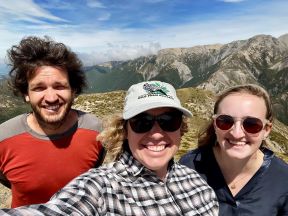A partnership between NZSki, University of Canterbury and the KCT
Tracking feral cats and mustelids using camera traps
Kea (Nestor notabilis) were once commonly observed on Mt Hutt on the eastern side of the Southern Alps in Canterbury, but their numbers have drastically declined, to the point that only one kea has been observed on the mountain for years. NZ Ski, Mt Hutt skifield managers, are concerned as to why kea have declined and are working with and part funding the Kea Conservation Trust to study Kea in the area and to understand the risk factors that may have contributed to the decline of Kea at Mt Hutt. As part of this partnership, University of Canterbury (UoC), with a summer scholarship from the School of Biological Sciences are carrying out a study on potential predator risks to Kea on the mountain.

Between January 2024 and March 2024, UoC researchers Dr Sara Kross, Professor Ximena Nelson and Michael Ramsbottom, deployed 40 camera traps in representative habitats across Mt Hutt to derive a measure of relative activity levels of feral cats and mustelids in the area.
L to R: Michael Ramsbottom, Sara Kross and MB Turnage
"This project will help to address two key knowledge gaps stated in the ‘Managing Threats’ section of the 2023 review document on kea “Kea (Nestor notabilis): a review of Kea ecology, threats, and research gaps for conservation”, in the specific context of Mt Hutt:
• “An improved understanding of how predator guilds and their impacts differ among kea habitats / sub-populations.”
• “An understanding of how, when, and where to control feral cats to minimise impacts on kea.”"
Results from this study will be used by NZSki's Mt Hutt ski area to better target introduced predators which are likely impacting local kea populations.
